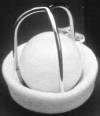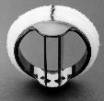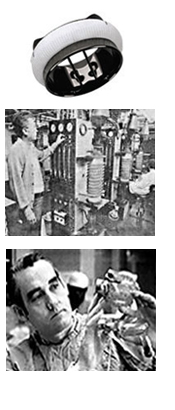On-X Heart Valve Story
Evolution of Mechanical Heart Valves
The On-X Prosthetic Heart Valve was introduced in 1996, exemplifying the wisdom and art of mechanical valve design as it has evolved over several decades.
 Valve replacements became a practical reality with the invention of the heart-lung machine in 1953. Soon, a broad variety of prosthetic valve designs emerged, mostly fashioned from metals or plastics. For more than a decade, the caged ball valve was recognized as the best choice for patients. One such design, the DeBakey-Surgitool Aortic valve, became the first valve to utilize pyrolytic carbon in its construction. A drawback to these early valves was their obstruction of the central flow path where blockage is least desirable.
Valve replacements became a practical reality with the invention of the heart-lung machine in 1953. Soon, a broad variety of prosthetic valve designs emerged, mostly fashioned from metals or plastics. For more than a decade, the caged ball valve was recognized as the best choice for patients. One such design, the DeBakey-Surgitool Aortic valve, became the first valve to utilize pyrolytic carbon in its construction. A drawback to these early valves was their obstruction of the central flow path where blockage is least desirable.
 Later, tilting disks allowed more centralized flow with reduced risk of blood damage and thrombosis potential. Successful models are still available today.
Later, tilting disks allowed more centralized flow with reduced risk of blood damage and thrombosis potential. Successful models are still available today.
 In the late 1970’s, St. Jude Medical introduced a new design with two hinged “leaflets” instead of a tilting disk. This design was the most successful of its time and has since become the most widely used. The bileaflet configuration is the least obstructive of mechanical designs.
In the late 1970’s, St. Jude Medical introduced a new design with two hinged “leaflets” instead of a tilting disk. This design was the most successful of its time and has since become the most widely used. The bileaflet configuration is the least obstructive of mechanical designs.
The success of the St. Jude valve spawned a group of similarly designed, similarly successful valves from other companies. These include valves from Carbomedics, ATS and Medtronic. Like the St. Jude, these bileaflet valves are made with silicon alloyed pyrolytic carbon.
 MCRI’s On–X valve design is also in the bileaflet tradition but represents an entirely new generation, extending the scope of benefit beyond all previous valves. With pure carbon construction and smoothly contoured surfaces, the On–X design successfully addresses fundamental issues that have beleaguered mechanical valves for decades–primarily thrombosis, stenosis and hemolysis.
MCRI’s On–X valve design is also in the bileaflet tradition but represents an entirely new generation, extending the scope of benefit beyond all previous valves. With pure carbon construction and smoothly contoured surfaces, the On–X design successfully addresses fundamental issues that have beleaguered mechanical valves for decades–primarily thrombosis, stenosis and hemolysis.
In 1965, when heart valve technology was still in its infancy, MCRI founder Jack Bokros, Ph.D., a nuclear engineer, collaborated with Dr. Vincent Gott about valve materials.
Dr. Gott was on a quest for a biocompatible material for heart valves and Dr. Bokros had recently developed a form of pyrolytic carbon for the nuclear industry.
For the ensuing three and a half decades, Dr. Bokros has remained at the center of both mechanical heart valve development and pyrolytic carbon technology. Over his career he has headed four separate companies dedicated to heart valve development and manufacturing, as he and his associates collaborated in the design of the St. Jude, Carbomedics and ATS valves.
Over time the Bokros team had developed a vision for a carbon heart valve that was unachievable with alloyed carbon technology. With the On-X carbon breakthrough of the early 1990’s, Dr. Bokros recognized the opportunity to renew his quest for “the ultimate valve”. He and his closest associates founded Medical Carbon Research Institute, LLC specifically for that purpose.
The resulting On-X valve is a credit to their vision and long years of endeavor. Dr. Bokros is justifiably optimistic that the On-X may indeed be the solution the medical community has sought for fifty years–a valve that is both durable and does not require intensive warfarin anticoagulation therapy.

